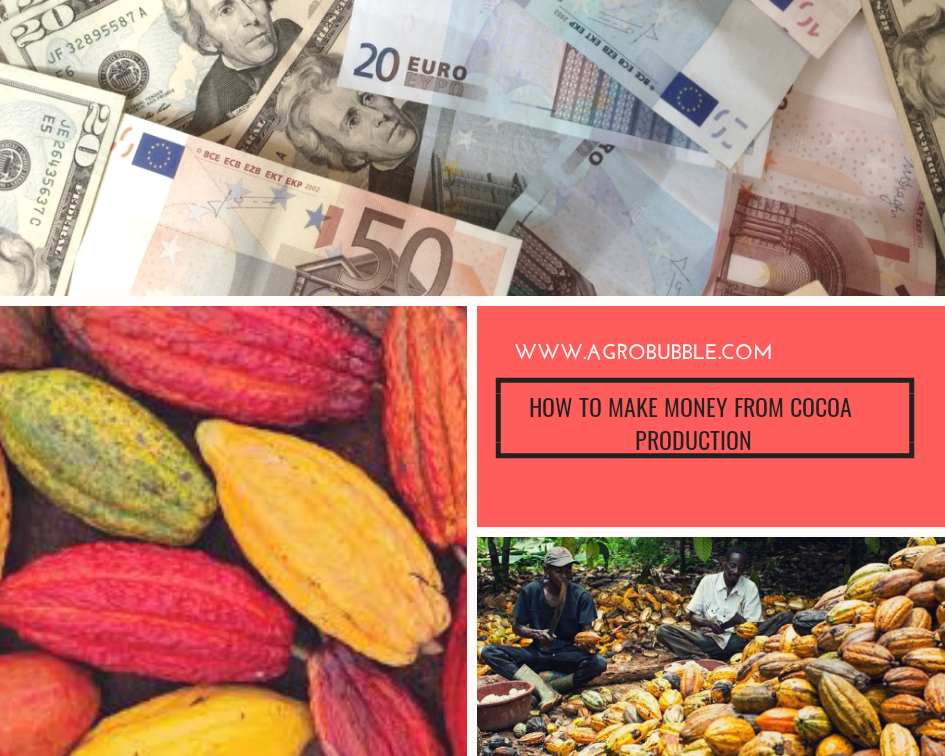Cocoa production is a very interesting topic you should pay strict attention to. “How to make money from cocoa production” is not something that happens overnight. Cocoa is a huge business investment if done well, will give you a high yielding profit of all time.
Most Cocoa producers, especially the rural farmers, fail to understand how the process operates.
Before starting Cocoa farm, there are various factors you need to consider such as, site preparation, crop varieties, soil management, weed control, and many other factors that will be treated in this post as you read on.
Cocoa (theobroma cacao L.) is native to Mexico, Central America and northern South America (Colombia, Ecuador, Venezuela, Brazil, Guyana, Suriname and French Guiana).
Cocoa has also been introduced as a crop plant into many tropical American and Asian Countries. And the major states in Nigeria that produce cocoa are Ondo, Cross River, Ogun, Akwa Ibom, Edo, Ekiti, Delta, Osun, and Oyo.
Read Also: How To Own Cassava Production For Free
SITE SELECTION FOR COCOA PRODUCTION
For a cocoa tree to grow well, it needs more than anything else, a soil with good structure that is permeable and deep.
Never plant cocoa trees in soil with a lot of stones, or in soil where there is a hard layer.
LAND PREPARATION FOR COCOA PRODUCTION
Land preparation and planting distance.
Land preparation is important to provide a good growth medium for cocoa seedling to be planted at the prospective place; the crop should be planted with a planting hole of sufficient size.
Take note that Cocoa planting distance is 3×3m or 4×2m, while the commonly used size of the hole is 60 X 60 X 60 cm.
Planting holes should be made 6 months prior to planting with green manure or manure inserted into the hollow.
No stones and the remnants of roots are allowed into the planting hole.
Parts of topsoil and subsoil should be lifted up from the hole in the opposite direction, the hole left open temporarily.
When closing the holes you may add organic matter, top soil is placed at the bottom of the hole, the subsoil at the top.
PLANTING DATE, TIME AND METHODS
Start clearing your field from the month of October for nursery practice.
Shade should be erected to protect the emerging seedling.
By November collect ripened hybrid cocoa and pre-germinate and sow in the nursery.
Maintain the nursery routinely up to May of the following year when the seedling will be due for transplanting.
Plants are grown in shade with a line with a distance of 75-100cm from the row of cocoa plants.
Plant shade still lies at the intersection of the diagonal line that connects the cocoa crop.
Temporary shade crop planted a year before the cocoa seedlings planted in the garden, as a benchmark that is easy for this condition is a young cocoa that only gets direct sun exposure for 2 hours (11:00 to 13:00).
Plants shade remains (like plantain) should be planted 1-2 years before the seedlings are planted in the garden.
SOIL MANAGEMENT FOR COCOA PRODUCTION
You can improve the soil structure by spreading manure and working it into the soil. If the soil is deep, the roots can go down to a good depth.
INTEGRATED SOIL FERTILITY MANAGEMENT
Fertilization is intended to supplement certain nutrients in the soil which is insufficient for the needs of cultivated plants.
See Also: Steps Needed For Putting Tomato Production Into Action
Fertilization should be done based on the principle of balance because fertilizers that contain a certain element in excess will interfere with absorption of other nutrients.
Maximum results will be obtained if the fertilization is done by:-
Proper dosage : according to table
Exact type : based on soil analysis
Appropriate time : the beginning and end of rainy season
Appropriate way : through the soil or leaf.
WATER MANAGEMENT
Cocoa should be cultivated in the areas where it thrives best,
Thrives better with average rainfall of between 1150mm and 2500mm, and a temperature range of 18°C to 32°C. Cocoa will not do well in drought prone areas.
WEED MANAGEMENT FOR COCOA PRODUCTION
The main aims of the weed control programme should be:-
. To minimize competition for moisture
. To minimize competition for nutrients
. To prevent weeds climbing up and engulfing the plant
. To allow easier access to the bushes for field operations
The weed control programmes is broken down to the following stages
. Pre-planting
. Establishment of shade
. Young immature cocoa in pre-coquette, say 0- ½ years
. Immature Cocoa, say ½ – 1 ½ year.
. Young mature cocoa, say 1 ½ – 4 years
. Mature cocoa, say 5 years+
Mistletoes
. At least 6 different species of Mistletoe have been found on cocoa.
. Regular removal of mistletoes is essential for good crop management and in healthy cocoa crops.
. Mistletoe may also provide a suitable habitat for ants (Crematogaster sp.) which cultivate the mealybug vectors of CSSV.
CROP MATURITY, HARVESTING AND STORAGE
Pods should be harvested as soon as they are ripe.
Harvesting should be done every two weeks.
It is essential that the pods do not become over-ripe as they are more likely to become infected with diseases.
What is your own take on this post? Use the COMMENT section below to share.

0 responses to “HOW TO MAKE MONEY FROM COCOA PRODUCTION”